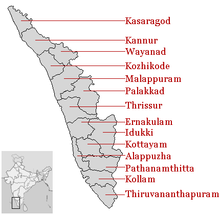Migrant labourers in Kerala
 |
|
| Total population | |
|---|---|
| (4 million ( 40 lakh)[2016]) | |
| Regions with significant populations | |
| Ernakulam | > 800,000 |
| Kozhikode | >400,000 |
| Palakkad | >400,000 |
| Thiruvananthapuram | >400,000 |
| Other districts | ~2,000,000 |
There are both economic and social imbalances among states in India and this leads to internal migration in general. High literacy rates, better education and lack of professional and skilled jobs had prompted Keralites to look for higher wages and skilled labour outside India. This trend has led to a decline in the availability of workforce in Kerala especially in unskilled jobs. Kerala has the lowest population growth rate in the country and is set to become the first state with zero population growth rate or with a negative growth rate. The child population growth is currently negative at -8.44%. In less than a decade, the Malayali population is set to decrease. Schools have been reporting vacancy of seats not because of drop in enrollment, but simply because there are no children to send. Therefore, with an ageing population like in Europe combined with the tendency of youth migrating abroad, the shortage of workers is bound to increase.
According to a study, Kerala is not able to create enough jobs suitable for an increasingly larger number of youngsters with high levels of education.Although lack of jobs was the main reason for migration of Keralites till 2000, the notion of higher wages abroad have become an addictive trend among Keralites even though currently the wages obtained in Kerala has become similar to those obtained abroad in many cases. Besides, the glamour associated with Gulf emigration is still very strong among the Kerala youngsters. This is an important positive factor in their decision to emigrate instead of working in the state.
According to a 2013 study conducted by Mr. M. P. Joseph IAS (R), Dr. D. Narayana and Dr. C. S. Venkiteswaran on behalf of the Gulati Institute of Finance and Taxation for the Department of Labour and Skills of the Government of Kerala, there are over 25 lakh(2.5 million) domestic migrant labourers in Kerala from other states of India, as well as from Bangladesh and Nepal, in 2016 this figure stood over 40 lakhs (4 million) with an annual arrival rate of 2.35 lakhs with a sum of Rs 25,000 crores going outside the state each year as wages to the migrant workers. According to official estimates, the expatriate Malayali population earns in excess of Rs. 75,000 crore annually. The number of migrant workers in Kerala is much larger compared to only 16 lakh (1.6 million) keralites working outside India In 2013, the number of migrant workers in Kerala was almost one-tenth of that of the local population which was about 33 million in 2011. It is estimated to rise as high as 48 lakhs(4.8 million) by 2023 despite the decline of migration of keralites to other countries for lucrative jobs. Besides, within 10 years, the majority of the local population would have aged above 40 years and this could lead to a further increase of migration from other states. In many cases, the high linguistic, social and cultural differences of Kerala and these other states and the large distance makes it similar to international migration rather than internal migration.
...
Wikipedia
